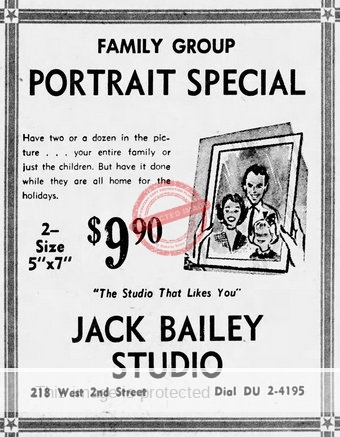The Chapala Blade, a short-lived 1960s’ tabloid, is almost certainly the earliest local periodical to be published at Lake Chapala. It began only a month or two after the first issue of the Guadalajara-based Colony Reporter. Unfortunately, almost no evidence remains of the Chapala Blade.

Credit: The Grand Island Independent, 2 Jan 1962, p11.
No copies of Chapala Blade are known to have survived. We don’t know who wrote or published it, or how many issues ever circulated. The limited, skeletal, information we have about the Chapala Blade comes from an article by a veteran U.S. journalist in a 1964 Nebraska newspaper.
Photographer and writer Jack Bailey (1901-1977) was visiting Guadalajara. Most of his article is about the beautiful rented home in the city, where friends (Mr and Mrs Paul Pappinfoss of St. Cloud, Minnesota) lived, and where they watched a Sunday bull fight on the television. He also describes a nearby “new housing project being financed by the Rockefeller interests. It covers an area of about 10 square blocks in which modest priced homes in the $7,000 bracket are being built for Mexicans and Americans who are looking for an inexpensive way of life.”
According to Bailey, the typical two-bedroom home in this development included a small backyard and a maid’s quarters of two rooms with a private bathroom. He was especially struck by the view down the street, which looked like “an artist’s palette after it had been used for months,” with homes “painted every color imaginable from bright red to royal purple, with blues, greens and yellows mixed in between.”
Bailey was on a day trip to Lake Chapala when he encountered the Chapala Blade, an experience which left an indelible impression on him:
While having lunch at Lake Chapala, a member of the fourth estate, if he could be called that, gave the newspaper business a black eye. He moved from table to table selling the Chapala Blade, a four page tabloid which told about the social happenings at Ajijic and Chula Vista.
After a diner purchased a paper he tried to sell them a yearly subscription to the sheet, a paper most people would have little use for. He stopped at our table and when we turned him down for the yearly subscription he put on his begging act, something you would not expect from an able-bodied 35-year-old American.
“I’m not like the other Americans who have retired down here,” he said. “This is my only of making a living. I have to sell subscriptions to the paper or I cannot live.”
We were so disgusted we could hardly show him any courtesy. He had come closer to begging than the poorest of the Indians who might have a reason. It certainly did not add respect for newspapermen.”
This is the only known reference to the Chapala Blade. If any copies ever come to light, they would surely offer some interesting insights into the rapidly expanding 1960s’ English-speaking community at Lakeside.
The best source for what Ajijic was like at that time, in terms of everyday living and events, is “Lotus Land,” a 21-page, mimeographed booklet about Ajijic penned by Ralph Jocelyn McGinnis (1894-1966), a U.S. sports writer, publicist and painter who was then living in the village.
Note: The first issue of the Colony Reporter (now The Guadalajara Reporter) left the presses in December 1963. The first issue of El Ojo del Lago came two decades later in 1984, the same year that a short-lived Ajijic-based publication named Welcome (produced by Andrés Ivon) also first appeared. Some years later, at the very end of the 1980s, the late Jorge Romo Rebeil published the Chapala Riviera Guide (which ran from 1989 to 1992) and La Ribera, its sister Spanish-language periodical.
Lake Chapala Artists & Authors is reader-supported. Purchases made via links on our site may, at no cost to you, earn us an affiliate commission. Learn more.
Source
- Jack Bailey. 1964. “View Low-Cost Housing Project. Prudent Matadors Leery of El Toro.” The Grand Island Daily Independent, (Nebraska): 31 March 1964, 10.
Comments, corrections and additional material welcome, whether via comments feature or email.
Tony Burton’s books include “Lake Chapala: A Postcard History” (2022), “Foreign Footprints in Ajijic” (2022), “If Walls Could Talk: Chapala’s historic buildings and their former occupants” (2020), (available in translation as “Si Las Paredes Hablaran”), “Mexican Kaleidoscope” (2016), and “Lake Chapala Through the Ages” (2008).
Truly interesting and most curious concerning the American trying to sell his paper.